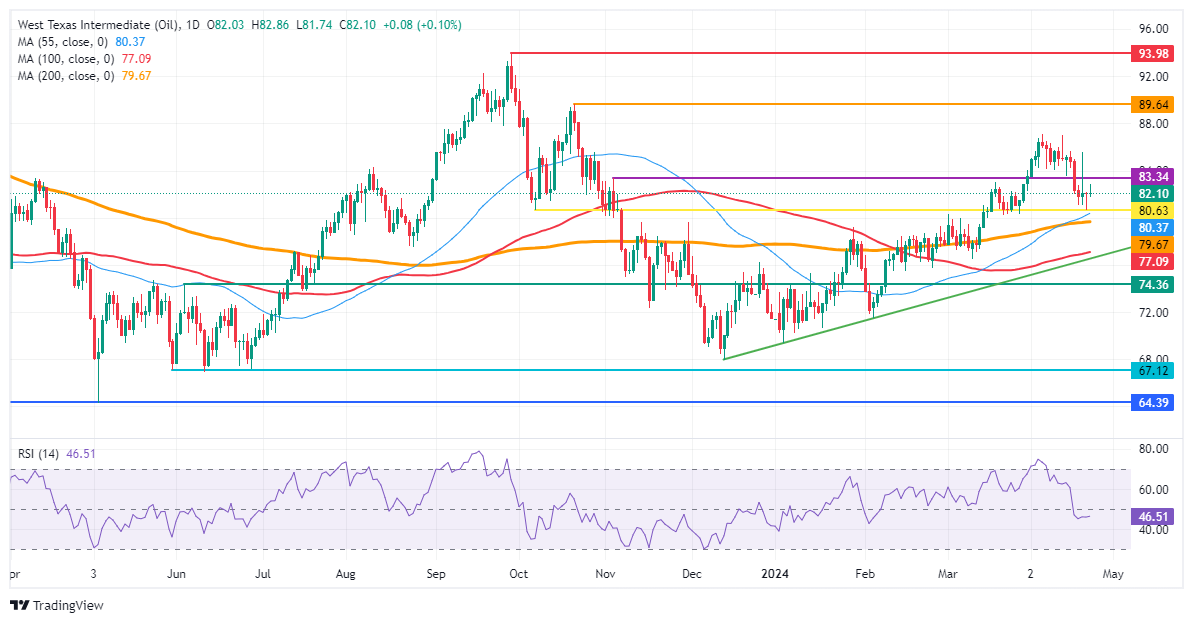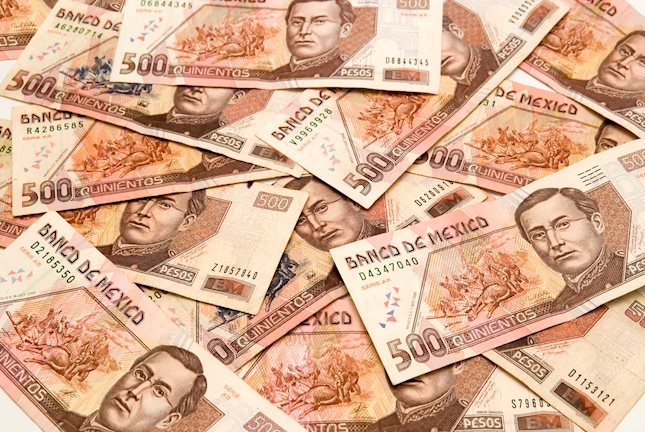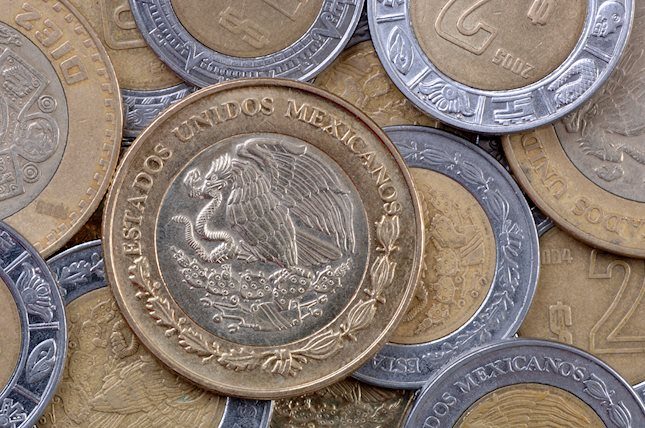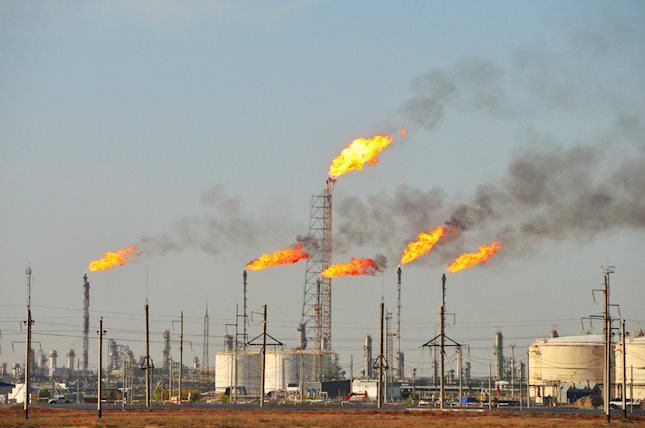Oil dips over 1% with Russian Oil export still at multi-month high
- Oil falls in the red on Russian Crude export numbers.
- WTI Oil falls back to $81.00
- The US Dollar Index ticked below 106.00 after strong Services PMIs from France, Germany and the Eurozone.
Oil prices are taking a turn for the worse this Tuesday with Russia back in focus. A Bloomberg report showed that Russia is still flooding the markets with its cheaper Oil, maintaining its multi-month high exports of seaborne crude exports. India and China are still the main customers despite US sanctions that are trying to barge these countries from buying that Russian Oil.
The US Dollar Index (DXY), which tracks the US Dollar’s value against six major currencies, faces a retracement and dips below 106.00 on Tuesday. Its biggest contributor, the Euro, which accounts for 57.6% of the basket, goes against the Greenback. The Euro jumped higher after surprise beats for both France, Germany and the Eurozone’s Services Purchasing Managers Index (PMI) data for April. Although the manufacturing sector is still in contraction, markets ignored that fact and sent the Euro higher on the back of the Services strong figures.
Crude Oil (WTI) trades at $81.18 and Brent Crude at $85.48 at the time of writing.
Oil news and market movers: There goes the bears
- Brent and WTI options see their call skews falling back in favor of a bearish outlook, with easing geopolitical risk fading this week.
- Russian Seaborn Exports are still near multimonth high volumes. Russian crude exports are up by about $24 million.
- The reopening of the Iraq-Turkey oil pipeline would add 500,000 barrels per day to the market. Turkey has already signalled that it is open and ready to receive flow after it had to halt the pipeline output due to earthquakes in February 2023, Bloomberg reported.
- Iran sanctions are expected to have a muted impact on Oil prices, according to Jim Lucier from Capital Alpha Partners. Lucier pointed out that US President Joe Biden will not want to risk another increase in Oil prices, which could trigger another surge in inflation and might risk his reelection possibilities in the upcoming US elections in November.
- At 20:30 GMT, the American Petroleum Institute (API) is set to release the weekly Crude Stockpile Changes for the week ending April 19, which is expected to rise by 1.8 million from a build of 4.09 million barrels seen the week before.
Oil Technical Analysis: Headlines on elevated Oil supply do not help
Oil prices are dipping again, erasing the positive return for this week and printing back at a loss in its performance. The fact that Russia is still able to sell its Oil to India and China shows that US sanctions are not working and probably more will need to be done. With meanwhile sanctions being issued against Iran, it looks like the Biden administration is walking a very thin line in order to get sanctions issued with disturbing the Oil prices in order to avoid a surge in inflation back home.
With geopolitical tensions lingering, the November 3 high at $83.34 and the $90 handle should remain as resistance on the upside. One small barrier in the way is $89.64, the peak from October 20. In case of further escalating tensions, expect even September’s peak at $94 to become a possibility, and a fresh 18-month high could be on the cards.
On the downside, the October 6 low at $80.63 is the next candidate as a pivotal support level. Below that level, the 55-day and the 200-day Simple Moving Averages (SMAs) at $80.37 and $79.67 should halt any further downturn.
US WTI Crude Oil: Daily Chart
WTI Oil FAQs
WTI Oil is a type of Crude Oil sold on international markets. The WTI stands for West Texas Intermediate, one of three major types including Brent and Dubai Crude. WTI is also referred to as “light” and “sweet” because of its relatively low gravity and sulfur content respectively. It is considered a high quality Oil that is easily refined. It is sourced in the United States and distributed via the Cushing hub, which is considered “The Pipeline Crossroads of the World”. It is a benchmark for the Oil market and WTI price is frequently quoted in the media.
Like all assets, supply and demand are the key drivers of WTI Oil price. As such, global growth can be a driver of increased demand and vice versa for weak global growth. Political instability, wars, and sanctions can disrupt supply and impact prices. The decisions of OPEC, a group of major Oil-producing countries, is another key driver of price. The value of the US Dollar influences the price of WTI Crude Oil, since Oil is predominantly traded in US Dollars, thus a weaker US Dollar can make Oil more affordable and vice versa.
The weekly Oil inventory reports published by the American Petroleum Institute (API) and the Energy Information Agency (EIA) impact the price of WTI Oil. Changes in inventories reflect fluctuating supply and demand. If the data shows a drop in inventories it can indicate increased demand, pushing up Oil price. Higher inventories can reflect increased supply, pushing down prices. API’s report is published every Tuesday and EIA’s the day after. Their results are usually similar, falling within 1% of each other 75% of the time. The EIA data is considered more reliable, since it is a government agency.
OPEC (Organization of the Petroleum Exporting Countries) is a group of 13 Oil-producing nations who collectively decide production quotas for member countries at twice-yearly meetings. Their decisions often impact WTI Oil prices. When OPEC decides to lower quotas, it can tighten supply, pushing up Oil prices. When OPEC increases production, it has the opposite effect. OPEC+ refers to an expanded group that includes ten extra non-OPEC members, the most notable of which is Russia.
Forex News
Keep up with the financial markets, know what's happening and what is affecting the markets with our latest market updates. Analyze market movers, trends and build your trading strategies accordingly.






















